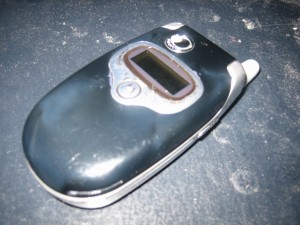Rob Walker ‘fesses up to having a “gadget death wish” in the latest Atlantic:
When I’ve confessed to others my enthusiasm for the breakdown of an expensive, enjoyable product, I’ve encountered surprising reinforcement. One friend said the debut of the white iPhone had her wishing a cruel fate upon her current smart phone. Another acquaintance, who blogs actively about cool new tech toys, confessed his constant yearning for one or another of his electronic possessions to require untimely replacement. A third described himself as “delighted” when his wife accidentally dunked his old iPhone in the Atlantic, “giving me the excuse I needed to get a 3G.”
I experienced an attack of gadget death wish just this week, thinking that my 2.5-year-old MacBook is running a bit slow and it wouldn’t be so terrible if I had to buy myself a new one — though, really, if I just cleared some junk off the hard drive, I expect it would function fine for years to come.
So I’m certainly not immune to gadget lust (iPad 2, I’m talking to you here). But in my case, it’s almost always outweighed by other factors. Laziness, cheapness, and guilt–proneness play into it. More than that, though, I get a real sense of satisfaction from sucking much more life out of a gadget than its manufacturers ever intended — a sort of Yankee-style frugality with a healthy dollop of f*ck-The-Man.
 My cell phone is old.Take, for example, my cell phone. The average American replaces her phone every 20.5 months (it used to be 18 months, but the sagging economy has slowed down the churn). I’ve had the same phone since early 2008 — more than twice as long as average. But my phone was already old when I got it, a hand-me-down from a tech-obsessed friend who had it moldering in the back of a desk drawer. How old? I’m not sure, but recently, watching The Wire on DVD, I noticed that hottie drug dealer Stringer Bell had my exact phone — in an episode that aired in 2004.
My cell phone is old.Take, for example, my cell phone. The average American replaces her phone every 20.5 months (it used to be 18 months, but the sagging economy has slowed down the churn). I’ve had the same phone since early 2008 — more than twice as long as average. But my phone was already old when I got it, a hand-me-down from a tech-obsessed friend who had it moldering in the back of a desk drawer. How old? I’m not sure, but recently, watching The Wire on DVD, I noticed that hottie drug dealer Stringer Bell had my exact phone — in an episode that aired in 2004.
On the unfortunate occasions when I have to call T-Mobile customer service, my irritation at phone menu trees and long stretches of elevator music is offset by a perverse pleasure when even “Bobby” from Bangalore is aghast that I’m still using such ancient technology. Wouldn’t I like to upgrade to an Omniscient-Android-Giga-Gadget, which I could get “free” with a two-year commitment to an extortionate service contract, or with the sacrifice of a limb of my choosing? Thanks but no thanks. My dumb-phone and cheap month-to-month rate plan suit me fine. The phone’s shiny blue coating recently peeled off, but otherwise it just keeps on ticking.
Much has been written about “planned obsolescence” — companies making products that frequently wear out or become outdated so customers will have to keep replacing them. But, as Walker points out in his Atlantic piece, “product obsolescence is becoming a demand-side phenomenon” in the case of electronic gizmos. Companies are now making gadgets that last longer than we want them to.
 But not this old.But that doesn’t mean consumers are to blame and manufacturers are just giving us what we want. As consumer-culture critic Annie Leonard has explained, the underlying problem isn’t merely that manufacturers make shoddy goods, but that they deliberately design goods to be un-upgradeable and un-repairable — “designed for the dump,” as she puts it. If your current iPhone could be easily upgraded from 3G to 4G, and the dinged-up casing easily replaced with a shiny new casing, all at a fraction of the cost of a new phone, many of us would sign right up. That’s a whole different way of thinking about design: make products that can be upgraded and adapted to future uses, or at the very least make them with parts that can be reused. Innovative designers are working toward that and many other great green goals.
But not this old.But that doesn’t mean consumers are to blame and manufacturers are just giving us what we want. As consumer-culture critic Annie Leonard has explained, the underlying problem isn’t merely that manufacturers make shoddy goods, but that they deliberately design goods to be un-upgradeable and un-repairable — “designed for the dump,” as she puts it. If your current iPhone could be easily upgraded from 3G to 4G, and the dinged-up casing easily replaced with a shiny new casing, all at a fraction of the cost of a new phone, many of us would sign right up. That’s a whole different way of thinking about design: make products that can be upgraded and adapted to future uses, or at the very least make them with parts that can be reused. Innovative designers are working toward that and many other great green goals.
Meanwhile, most manufacturers are still wedded to the old models. So, for now, you can play their game and revel in the fleeting pleasure of being one of the first with a flashy new toy. Or you could savor a more refined, enduring pleasure — being one of the last to keep an old toy in operation, or one of the few who’ve managed to fix or upgrade the toy yourself, or a hold-out who’s survived without any version of the toy at all. Walker admits to experiencing some of the latter as well as the former in a follow-up post on the Design Observer blog, noting that he himself has a really old phone.
Much as I enjoy this game, I know I’m an amateur. I’d love to hear from all of you resourceful economizers out there who’ve got more to brag about than hanging on to a seven-year-old cell phone. Please share.



